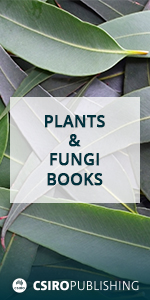
Functional Plant Biology
Volume 39 Number 6 2012
FP11251Comparative transcriptional profiling of two rice genotypes carrying SUB1A-1 but exhibiting differential tolerance to submergence
Submergence tolerance is an important trait in lowland rice and is physiologically complex itself. Our aim was to understand its molecular basis and our results suggest that higher expression of antioxidant genes in the cultivar FR13A contributes to its greater tolerance to submergence. Making further improvements in submergence tolerance in lowland rice is likely to be by combining a locus for oxidative resistance with the known tolerance-conferring SUB1A-1 gene.
FP12008The role of SORBITOL DEHYDROGENASE in Arabidopsis thaliana
A new metabolic path for ribitol metabolism in Arabidopsis thaliana and the adverse effects caused by its disruption are shown. SORBITOL DEHYDROGENASE plays a primary and unexpected role in this newly-discovered step. This work adds to the basic knowledge of polyol metabolism in plants.
FP11277Seasonal effects on the relationship between photosynthesis and leaf carbohydrates in orange trees
Photosynthesis and carbohydrate availability affect the growth of citrus trees, evergreen plants subjected to seasonal changes in environmental conditions. Our aim was to understand the effect of summer and winter on the relationships between leaf carbohydrate and photosynthesis in citrus trees. A positive association was found between photosynthesis and photoassimilate use, even with leaves showing high carbohydrate during the summer. We provide evidence that photosynthesis in citrus leaves is regulated by an increase in sink demand rather than by the absolute carbohydrate concentration.
FP11254Time of pruning affects fruit abscission, stem carbohydrates and yield of macadamia
Macadamia trees are hedged in early spring to control tree size but this reduces yield, largely through competition for carbohydrates between fruit set and post-pruning shoot growth. We show that pruning in late spring or early summer reduced the decrease in yield. This is consistent with the idea that fruit become less sensitive to carbon limitation as they mature.
FP12031Rootstocks affect pear (Pyrus communis) tree growth through extent of node neoformation and flowering with key differences to apple
Pear production has declined in recent years in New Zealand due to production difficulties. Improved rootstock selection would overcome some of these issues and therefore better understanding of rootstock effects on tree growth is essential to facilitate rootstock breeding. This study found that rootstock affected the extent of shoot growth, branching and flowering in pear trees in the first three years of growth. Findings will be used to guide pear rootstock breeding programmes.
FP12042Amino acids are a nitrogen source for sugarcane
Understanding organic nitrogen use of plants is important since synthetic fertilisers can be easily lost from the soil. Sugarcane was shown to have a well developed capacity to use amino acids for growth and supply of amino acids rather than inorganic nitrogen led to a shift in internal metabolites. Metabolite profiling may advance knowledge of crop nitrogen sources and this will aid in the development of cropping systems with a reduced nitrogen pollution footprint.
FP11291Leaf traits and persistence of relict and endangered tree species in a rare plant community
In a rare plant community, many tree species have been identified as Tertiary relict and endangered plants, yet their persistence are poorly understood. We found that they had similar leaf traits as coexisting deciduous non-endangered species and their leaf trait relationships were significant. Our results indicate that leaf trait patterns will contribute to our understanding of adaptive strategies of plants and hence their persistence.
FP12007Functional unfold principal component analysis for automatic plant-based stress detection in grapevine
It is important to detect drought in grapevines in an early stage because the water status strongly affects the quality of the grapes and resulting wine. An innovative methodology for drought detection in plants is presented here, which gives a warning when measured stem diameter variations deviate from their normal behaviour. Therefore, drought can easily be detected in an early stage, i.e. days before visible symptoms appear, which is essential for taking appropriate management actions to preserve health and quality.
FP12004Münch without tears: a steady-state Münch-like model of phloem so simplified that it requires only algebra to predict the speed of translocation
For more than 80 years, the creation of a mathematically simple physiological model describing sugar transport through a plant has frustrated plant biologists. Such a model should combine loading and unloading of sugar, osmosis and elementary hydraulics. This paper describes such a model and requires only simple algebra for its formulation and solution.




